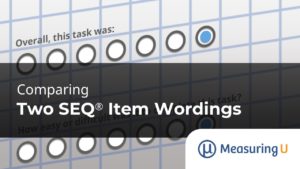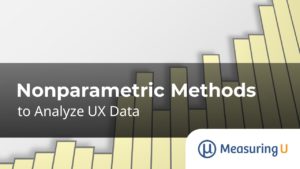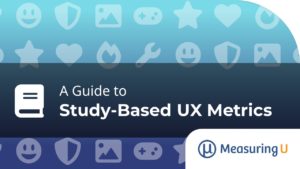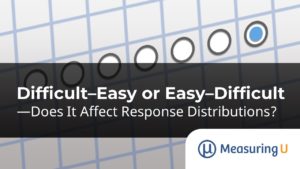Topics
Topics

Comparison of SEQ With and Without Numbers
Over the past few months, we’ve conducted several studies with different versions of the seven-point Single Ease Question (SEQ®), a popular task-level metric for perceived ease-of-use. As we’ve seen with other research on rating scales, response means tend to be rather stable despite often salient changes to formatting. In our earlier SEQ research, we found

UX and NPS Benchmarks of Airline Websites (2022)
Air travel was one of the sectors most impacted by the pandemic. The summer of 2022 has seen air travel return to—or, in some cases, exceed—pre-pandemic levels. But the return to the skies has not been without turbulence. Shortages in staff and planes have resulted in a record number of delayed and canceled flights, making

How to Compare Two Proportions with the N−1 Two-Proportion Test
Proportional data is common in both UX research and the larger scientific literature. You can use proportions to help make data-driven decisions just about anywhere: Which design converts more? Which product is preferred? Does the new interface have a higher completion rate? What proportion of users had a problem with registering? Consequently, you’ll likely want to

The Methods UX Professionals Use (2022)
The wide range of UX methods is one of the things that makes UX such an interesting field. Some methods, like usability testing, have been around for decades. Others are more recent additions, and some seem to be just slight variations on other existing methods. We’ve been tracking and analyzing the methods UX professionals reported

Comparing Two SEQ Item Wordings
We use the seven-point Single Ease Question (SEQ®) frequently in our practice, as do many other UX researchers. One reason for its popularity is the body of research that started in the mid-2000s with the comparison of the SEQ to other similar short measures of perceived ease-of-use, the generation of a normative SEQ database, and

The Many Ways of Thinking Aloud
The Think Aloud method (TA) is one of the most distinguishing characteristics of usability testing. The method involves having participants speak their thoughts as they attempt tasks on an interface. We often think of the TA method as a single method, but there are substantial variations in how it’s implemented. In an earlier article, we

UX and NPS Benchmarks of Real Estate Websites (2022)
Of the many industries impacted by the pandemic, residential real estate is certainly among the top few, along with short-term rentals, online meal/grocery delivery, hotels, and airline travel. Real estate websites offer a nearly real-time inventory of available properties for sale and rent. The popularity of these sites surged as waves of people sought to

Should You Use Nonparametric Methods to Analyze UX Data?
Near the top of the list of concerns people have when using statistics with UX data is what to do with non-normal data. If you remember only a few things from statistics class, you might recall something about data needing to look like the infamous bell curve; more specifically, it needs to be normally distributed.

User Experience Salaries & Calculator (2022)
Every couple of years (or so) we assist our friends at the UXPA in helping the UX community understand the latest compensation, skills, and composition of the UX profession. The UXPA salary survey didn’t go out in 2020 because of the impacts of the pandemic, but we’re happy to have a new set of data

A Guide to Study-Based UX Metrics
For quantifying the user experience of a product, app, or experience, we recommend using a mix of study-level and task-based UX metrics. In an earlier article, we provided a comprehensive guide to task-based metrics. Tasks can be included as part of usability tests or UX benchmark studies. They involve having a representative set of users

Difficult–Easy or Easy–Difficult—
Does It Affect Response Distributions?
The seven-point Single Ease Question (SEQ®) has become a standard in assessing post-task perceptions of ease. Since the SEQ’s inception, we have collected data from thousands of task experiences to generate a normalized database of scores. We have also established its strong correlation to task completion and task time. Over the years, some researchers have

UX and NPS Benchmarks of News Websites (2022)
The pandemic had sudden and significant impacts on many industries, including grocery delivery, online meeting software, and vacation rentals. Understandably, people significantly increased their visits to news websites to understand the impacts of the virus and governments’ responses to it. Fake news and misinformation; fact-checkers who need fact-checkers: it’s become challenging to disentangle the biases